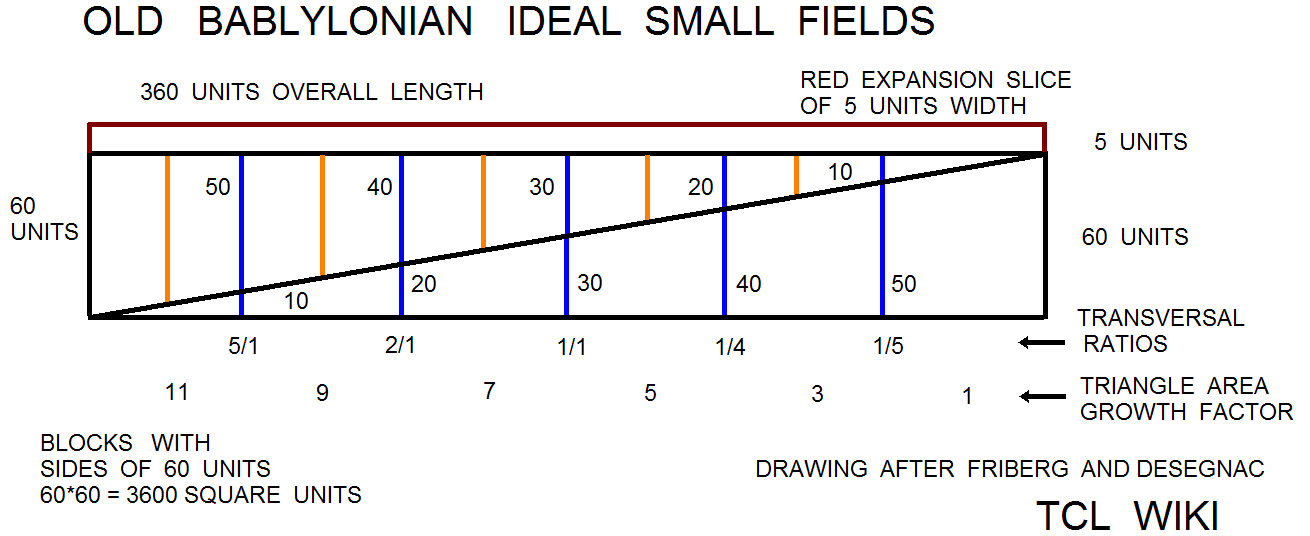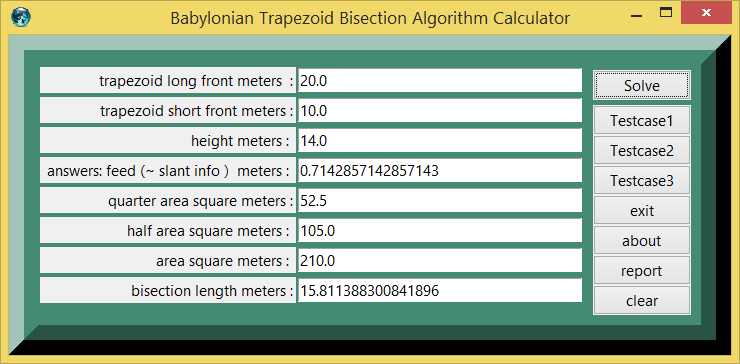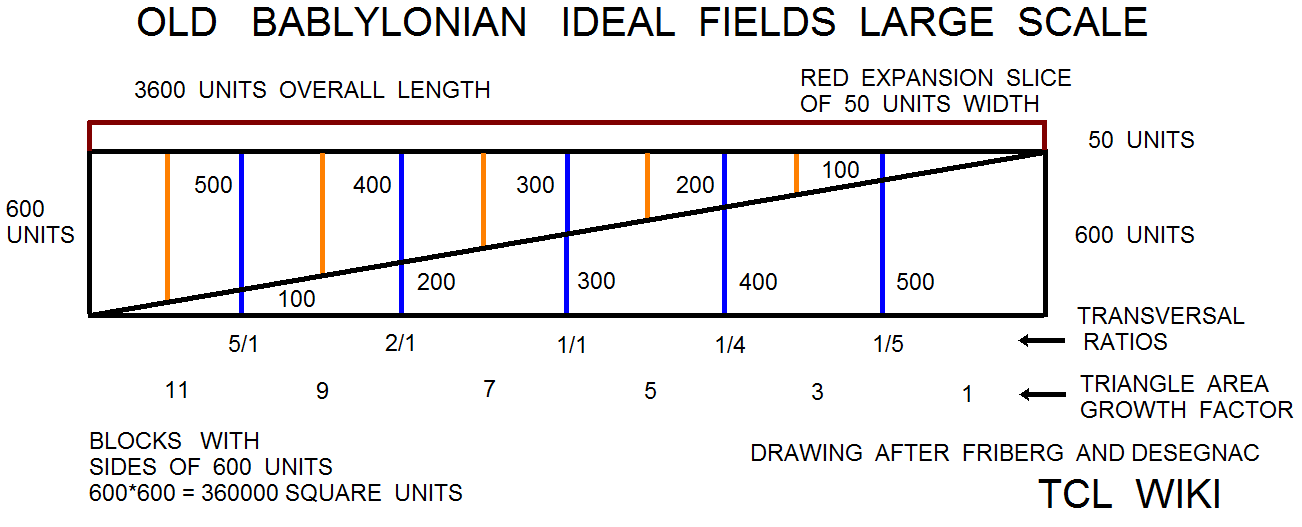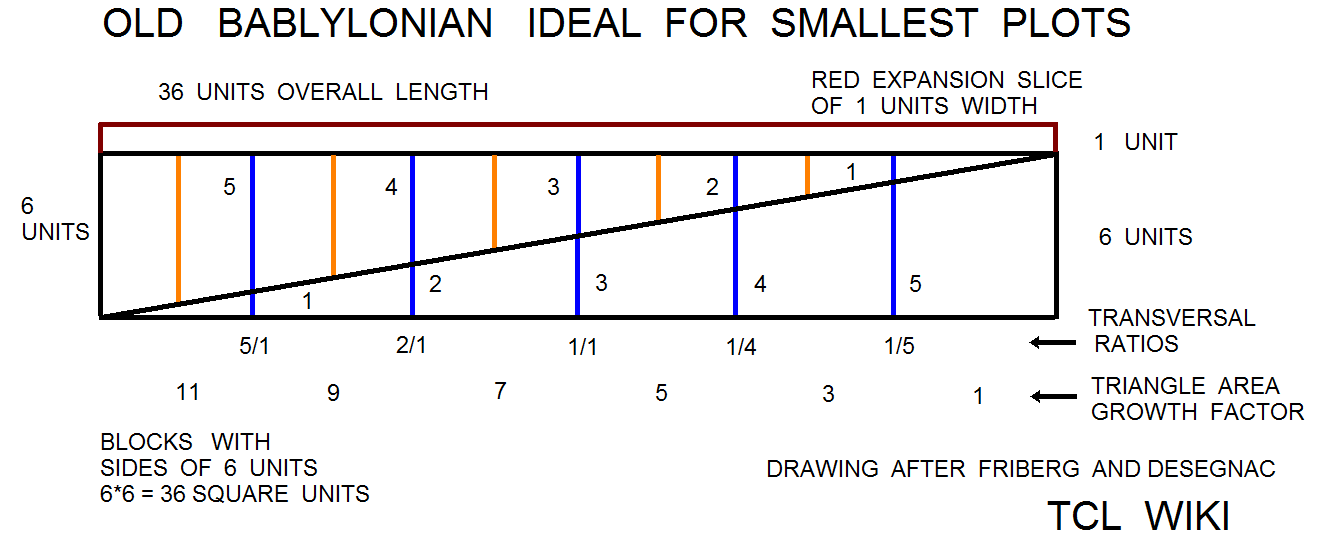Babylonian Trapezoid Bisection Algorithm and eTCL demo example calculator, numerical analysis
Babylonian Trapezoid Bisection Algorithm and eTCL demo example calculator, numerical analysis
This page is under development. Comments are welcome, but please load any comments in the comments section at the bottom of the page. Please include your wiki MONIKER and date in your comment with the same courtesy that I will give you. Aside from your courtesy, your wiki MONIKER and date as a signature and minimal good faith of any internet post are the rules of this TCL-WIKI. Its very hard to reply reasonably without some background of the correspondent on his WIKI bio page. Thanks, gold 12Dec2018
- Babylonian Trapezoid Bisection Algorithm and eTCL demo example calculator, numerical analysis
- Preface
- Introduction
- Pseudocode Section
- Appendix Code
- Comments Section
Preface
gold Here is some eTCL starter code for Babylonian trapezoid bisection algorithm.
Introduction
The Babylonian trapezoid bisection algorithm was loaded into an eTCL calculator. The Babylonians did not use algebra notation, so the reader will have to bear some anachronisms in the eTCL pseudocode. For restating the problem in a computer algorithm, the sides and field area will be in meters and square meters, respectively.
In looking for testcases, some ideal field plans of different scales was constructed from common features of several cuneiform math problems, based on Friberg and DeSegnac. Note that the small triangle comes to a point and can not be treated like a trapezoid with a small side of zero. Some problems appear to use an expansion slice, maybe to be assured of a trapezoid at the smallest section. An iku is 3600 square meters equivalent to 60 meters on side. For the small fields with unit set to 1 meter, the block is equivalent to one iku and 18 blocks are equal to one berum (estate). From the small fields diagram, the larger trapezoid of l/f/h 60/50/60 was loaded into the calculator and returned an area of 3300 square meters with a feed 0.166 and bisection of 55.22 meters. As a check, the area of the small triangle was .5*60*10 or 300 square meters. 300 plus 3300 equals the 3600 square meters of the standard block. From bisection**2 = base**2– feed * Area, bisection**2= 60*60-0.166*3300, bisection = sqrt 3052.2 = 55.246 meters.
For the chart on smallest plots, a sar (garden) is 36 square meters equivalent to 6 meters on the side. With unit set to 1 meter, the block is equivalent to one sar and 100 blocks are equal to one iku (field). The smallest triangle would be (1/2)*b*h = 0.5*6*1 equals 3 square meters. The largest triangle would be (1/2)*b*h = 0.5*6*36 equals 108 square meters.
Pseudocode Section
# using pseudocode for Babylonian trapezoid bisection algorithm.
# possible problem instances include trapezoid split in 2 to 7 sections
long_front = supplied value
short_front = supplied value
height = supplied value
solve for bisection length, trapezoid full area, feed (~~ slant info )
# bisection rule d**2 = (a**2+b**2) /2, d = sqrt ((a**2+b**2) /2)
set trapezoid_area h*((a+b)/2)
set feed ($long_front - $short_front)/$height , negative feed?, need abs
set bisection [* [+ [* $long_front $long_front ] [* $short_front $short_front] ] .5 ]
set bisection [sqrt $bisection ]
half area = trapezoid_area * .5
quarter area = trapezoid_area * .25
check_answer trapezoid area =? true_area , second formula (yes/no)
set answers and printout with resulting valuesTestcases Section
In planning any software, it is advisable to gather a number of testcases to check the results of the program. The math for the testcases can be checked by pasting statements in the TCL console. Aside from the TCL calculator display, when one presses the report button on the calculator, one will have console show access to the capacity functions (subroutines).
Testcase 1
| table 1 | printed in | tcl wiki format |
|---|---|---|
| quantity | value | comment, if any |
| 1: | testcase_number | |
| 20.0 : | trapezoid long front meters | |
| 10.0 : | trapezoid short front meters | |
| 14.0 : | height meters | |
| 0.714 : | answers: feed (~ slant info ) meters | |
| 52.5 : | quarter area square meters | |
| 105.0 : | half area square meters | |
| 210.0 : | full area square meters | |
| 15.811 : | bisection length meters |
Testcase 2
| table 2 | printed in | tcl wiki format |
|---|---|---|
| quantity | value | comment, if any |
| 2: | testcase_number | |
| 120.0 : | trapezoid long front meters | |
| 60.0 : | trapezoid short front meters | |
| 80.0 : | height meters | |
| 0.75 : | answers: feed (~ slant info ) meters | |
| 1800.0 : | quarter area square meters | |
| 3600.0 : | half area square meters | |
| 7200.0 : | full area square meters | |
| 94.868 : | bisection length meters |
Testcase 3
| table 3 | printed in | tcl wiki format |
|---|---|---|
| quantity | value | comment, if any |
| 3: | testcase_number | |
| 360.0 : | trapezoid long front meters | |
| 120.0 : | trapezoid short front meters | |
| 20.0 : | height meters | |
| 12.0 : | answers: feed (~ slant info ) meters | |
| 1200.0 : | quarter area square meters | |
| 2400.0 : | half area square meters | |
| 4800.0 : | full area square meters | |
| 268.328 : | bisection length meters |
Screenshots Section
figure 1.
figure 2.

figure 3.
figure 4.
References:
- A Geometric Algorithm with Solutions to Quadratic Equations
- in a Sumerian Juridical Document from Ur III Umma
- Joran Friberg, Chalmers University of Technology, Gothenburg, Sweden
- google search engine <Trapezoid area bisection>
- Wikipedia search engine <Trapezoid area >
- mathworld.wolfram.com, Trapezoid and right trapezoid
- Mathematical Treasure: Old Babylonian Area Calculation, uses ancient method
- Frank J. Swetz , Pennsylvania State University
- Wikipedia, see temple of Edfu, area method used as late as 200 BC in Egypt.
- Oneliner's Pie in the Sky
- One Liners
- Category Algorithm
- Babylonian Number Series and eTCL demo example calculator
- Brahmagupta Area of Cyclic Quadrilateral and eTCL demo example calculator
- Gauss Approximate Number of Primes and eTCL demo example calculator
- Land surveying in ancient Mesopotamia, M. A. R. Cooper
- Sumerian Approximate Area Quadrilateral and eTCL Slot Calculator Demo Example , numerical analysis
- Thomas G. Edwards, Using the Ancient Method of False Position to Find Solutions
- Joy B. Easton, rule of double false position
- Vera Sanford, rule of false position
- www.britannica.com, topic, mathematics trapezoid
- Sumerian Equivalency Values, Ratios, and the Law of Proportions with Demo Example Calculator
- Babylonian Sexagesimal Notation for Math on Clay Tablets in Console Example
- Babylonians Tracked Jupiter With Advanced Tools: Trapezoids, Michael Greshko, news.nationalgeographic.com
- Geometry in Babylonian Astronomy, Cluster of Excellence Topology, Humboldt University of Berlin
- Mathieu Ossendrijver: „Ancient Babylonian astronomers calculated Jupiter’s position
- from the area under a time-velocity graph“, in: Science, January 29, 2016.
- Late Babylonian Field Plans in the British Museum, books.google.com/books
- Karen Rhea Nemet-Nejat
- Late Babylonian Surface Mensuration Author(s): Marvin A. Powell Source: jstor
- translation: trapezoid in two babylonian astronomical cuneiform
- texts for jupiter (act 813 & act 817) from the seleucid era , 310 BC -75 AD
- Otto Neugebauer, Astronomical Cuneiform Texts, 3 Vols.
- Lund Humphreys, London, 1955:405,430-31.
- DeSegnac, MS 3908 A RE-CONSTRUCTION, D.A.R. DeSegnac
- A draft for an essay
- DeSegnac, MENTAL COMPUTING OF THREE ARCHAIC
- MESOPOTAMIAN PUZZLES W 20044, 35, W 20044, 20 & W 20214, essay draft
- DeSegnac, HARMONY OF NUMBERS I and II, D.A.R. DeSegnac, A draft for an essay
Appendix Code
appendix TCL programs and scripts
# pretty print from autoindent and ased editor
# Babylonian Trapezoid Bisection Algorithm calculator
# written on Windows XP on eTCL
# working under TCL version 8.5.6 and eTCL 1.0.1
# gold on TCL WIKI, 15jan2017
package require Tk
package require math::numtheory
namespace path {::tcl::mathop ::tcl::mathfunc math::numtheory }
set tcl_precision 17
frame .frame -relief flat -bg aquamarine4
pack .frame -side top -fill y -anchor center
set names {{} { trapezoid long front meters :} }
lappend names { trapezoid short front meters :}
lappend names { height meters : }
lappend names { answers: feed (~ slant info ) meters : }
lappend names { quarter area square meters :}
lappend names { half area square meters : }
lappend names { area square meters : }
lappend names { bisection length meters :}
foreach i {1 2 3 4 5 6 7 8} {
label .frame.label$i -text [lindex $names $i] -anchor e
entry .frame.entry$i -width 35 -textvariable side$i
grid .frame.label$i .frame.entry$i -sticky ew -pady 2 -padx 1 }
proc about {} {
set msg "Calculator for Babylonian Trapezoid Algorithm
from TCL WIKI,
written on eTCL "
tk_messageBox -title "About" -message $msg }
proc calculate { } {
global answer2
global side1 side2 side3 side4 side5
global side6 side7 side8
global testcase_number
incr testcase_number
set side1 [* $side1 1. ]
set side2 [* $side2 1. ]
set side3 [* $side3 1. ]
set side4 [* $side4 1. ]
set side5 [* $side5 1. ]
set side6 [* $side6 1. ]
set side7 [* $side7 1. ]
set side8 [* $side8 1. ]
set long_front $side1
set short_front $side2
set height $side3
set feed [abs [/ [- $long_front $short_front ] $height ] ]
set area [* [* [+ $long_front $short_front] .5 ] $height ]
# bisection rule d**2 = (a**2+b**2) /2, d = sqrt ((a**2+b**2) /2)
set bisection [* [+ [* $long_front $long_front ] [* $short_front $short_front] ] .5 ]
set bisection [sqrt $bisection ]
set side4 $feed
set side5 [* $area 0.25 ]
set side6 [* $area 0.5 ]
set side7 $area
set side8 $bisection
}
proc fillup {aa bb cc dd ee ff gg hh} {
.frame.entry1 insert 0 "$aa"
.frame.entry2 insert 0 "$bb"
.frame.entry3 insert 0 "$cc"
.frame.entry4 insert 0 "$dd"
.frame.entry5 insert 0 "$ee"
.frame.entry6 insert 0 "$ff"
.frame.entry7 insert 0 "$gg"
.frame.entry8 insert 0 "$hh"
}
proc clearx {} {
foreach i {1 2 3 4 5 6 7 8 } {
.frame.entry$i delete 0 end } }
proc reportx {} {
global side1 side2 side3 side4 side5
global side6 side7 side8
global testcase_number reference_factor flag
console show;
puts "%|table $testcase_number|printed in| tcl wiki format|% "
puts "&| quantity| value| comment, if any|& "
puts "&| $testcase_number:|testcase_number | |& "
puts "&| $side1 :|trapezoid long front meters | |&"
puts "&| $side2 :|trapezoid short front meters| |& "
puts "&| $side3 :|height meters| |& "
puts "&| $side4 :|answers: feed (~ slant info ) meters| |&"
puts "&| $side5 :|quarter area square meters | |&"
puts "&| $side6 :|half area square meters | |&"
puts "&| $side7 :|full area square meters | |&"
puts "&| $side8 :|bisection length meters | |&"
}
frame .buttons -bg aquamarine4
::ttk::button .calculator -text "Solve" -command { calculate }
::ttk::button .test2 -text "Testcase1" -command {clearx;fillup 20.0 10. 14.0 .71 52.5 105. 210. 15.8}
::ttk::button .test3 -text "Testcase2" -command {clearx;fillup 120. 60. 80. .75 1800.0 3600. 7200. 95. }
::ttk::button .test4 -text "Testcase3" -command {clearx;fillup 360.0 120. 20.0 12.66 1200.0 2400. 4800. 268.0 }
::ttk::button .clearallx -text clear -command {clearx }
::ttk::button .about -text about -command {about}
::ttk::button .cons -text report -command { reportx }
::ttk::button .exit -text exit -command {exit}
pack .calculator -in .buttons -side top -padx 10 -pady 5
pack .clearallx .cons .about .exit .test4 .test3 .test2 -side bottom -in .buttons
grid .frame .buttons -sticky ns -pady {0 10}
. configure -background aquamarine4 -highlightcolor brown -relief raised -border 30
wm title . "Babylonian Trapezoid Bisection Algorithm Calculator" Pushbutton Operation
For the push buttons, the recommended procedure is push testcase and fill frame, change first three entries etc, push solve, and then push report. Report allows copy and paste from console.
For testcases in a computer session, the eTCL calculator increments a new testcase number internally, eg. TC(1), TC(2) , TC(3) , TC(N). The testcase number is internal to the calculator and will not be printed until the report button is pushed for the current result numbers. The current result numbers will be cleared on the next solve button. The command { calculate; reportx } or { calculate ; reportx; clearx } can be added or changed to report automatically. Another wrinkle would be to print out the current text, delimiters, and numbers in a TCL wiki style table as
puts " %| testcase $testcase_number | value| units |comment |%" puts " &| volume| $volume| cubic meters |based on length $side1 and width $side2 |&"
Comments Section
Please place any comments here, Thanks.


